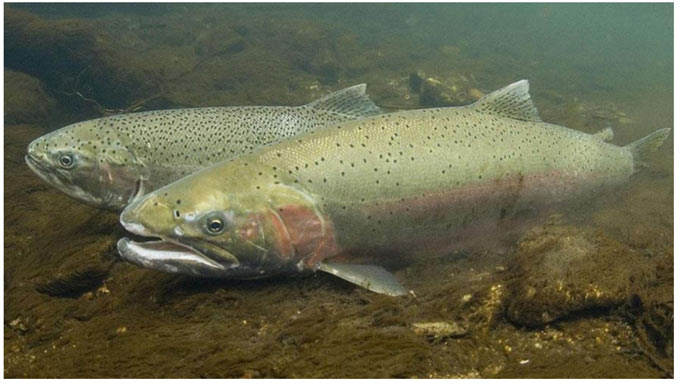
Male and female steelhead trout. (Image credit: NOAA Fisheries)
Download Image
What you need to know: California is marking significant progress with the state’s salmon strategy – completing major projects, repopulating areas for the first time in more than a century and funding key projects in the Central Valley.
November 26, 2025 - SACRAMENTO – In just the last week, California approved seven new salmon restoration projects in the Central Valley, marked significant progress in bringing salmon back to the Klamath River, and celebrated the completion of a major fish passageway along the Sacramento River. It’s all proof that the California Salmon Strategy for a Hotter, Drier Future — combined with its Healthy Rivers and Landscapes program — is paying dividends nearly two years since Governor Gavin Newsom first announced the plan.
Salmon are an integral part of our shared history in California. We’re doubling down to make sure this species not only adapts in the face of extreme weather but remains a fixture of California’s natural beauty and ecosystems for generations to come.
Governor Gavin Newsom
Salmon are profoundly important to California. They provide important commercial, recreational, economic, intrinsic and cultural benefits to fishing communities, California Native American tribes, and the entire state. California’s salmon populations are struggling to recover from years of drought, climate disruption, and other environmental and human-made challenges. California is taking significant and meaningful steps to rebuild salmon stocks across California.
“It is encouraging to see what is possible once we begin to restore balance to the lands and waters that now make up California,” said Tribal Affairs Secretary Christina Snider-Ashtari. “For so many tribal nations throughout the state who have long advocated for this restoration, the return of salmon also means the return of traditions, lifeways, and well-being for their communities.”
Earlier this year, the state released the California Salmon Strategy for a Hotter, Drier Future: Progress Report, an update to the original strategy. The progress report shows that of the 71 action items outlined in the Salmon Strategy, nearly 70% are underway, with another 26% already completed. These actions provide tangible benefits for California’s salmon populations and habitats now and into the future.
Even as some salmon populations begin to rebound in the state, salmon fisheries continue to face significant climate-related challenges. California’s commercial salmon fisheries have been closed for three years, and recreational salmon fishing just started to open this year for limited opportunities.
Restoring salmon in the Central Valley
Last week, the California Wildlife Conservation Board (WCB) approved seven projects that will restore critical habitat and remove fish passage barriers in the Central Valley.
Totaling over $70 million, these seven projects advance early implementation of theHealthy Rivers and Landscapes program, an unprecedented collaboration of local, state, and federal water partners to improve environmental flows and restore habitats along California’s key waterways. By reconnecting rivers to floodplains, modernizing water infrastructure, and restoring spawning and rearing habitat, these projects also directly address priorities identified in the state’s Salmon Strategy.
Here are some of the recently approved projects:
- Battle Creek Ranch, Tehama County: Secures 313 acres of high-value spawning and rearing habitat for endangered spring-run and winter-run Chinook salmon and steelhead, complementing ongoing restoration efforts and protecting critical tributary systems.
- Meridian Farms Fish Screen, Sutter County: Consolidates two unscreened diversions on the Sacramento River into a single screened diversion, reducing juvenile salmon mortality and supporting recovery of Central Valley spring-run and winter-run Chinook salmon.
- Robinson’s Riffle Feather River Restoration, Butte County: Reshapes roughly one mile of the Feather River and reconnects it to 51 acres of historic floodplain, creating high-quality spawning and rearing habitat for Chinook salmon and steelhead while increasing overall habitat diversity.
Explore all the projects on WCB’sstory maps page.
‘Salmon everywhere’ in the Klamath
A little more than a year after the historic removal of four hydroelectric dams on the Klamath River, California Department of Fish and Wildlife (CDFW) scientists are seeing salmon reoccupying just about every corner of their historic habitat. This is a key milestone for the Governor’s Salmon Strategy.
“The speed at which salmon are repopulating every nook and cranny of suitable habitat upstream of the dams in the Klamath Basin is both remarkable and thrilling,” said Michael Harris, Environmental Program Manager of CDFW’s Klamath Watershed Program. “There are salmon everywhere on the landscape right now, and it’s invigorating our work.”
While adult returns of salmon are ongoing and final estimates won’t be available until January, initial reports indicate a stronger fall-run Chinook salmon return than last year with widespread dispersal of the fish. Recent signs of salmon recovery throughout the Klamath Basin include:
- The Oregon Department of Fish and Wildlife and the Klamath Tribes report seeingwidespread salmon spawning within the Oregon portion of the Klamath River, including within multiple tributaries upstream of Klamath Lake where salmon haven’t been seen in more than a century.
- Fish-counting stations have recorded 214 adult Chinook salmon in Jenny Creek and 260 adult Chinook salmon in Shovel Creek to date. CDFW field crews are surveying regularly for salmon nests and adult fish.
A primary goal of Klamath River dam removal was the reestablishment of viable, wild, self-sustaining populations of salmon and other anadromous fish species for conservation, for their ecological benefits, and to enhance tribal, commercial and recreational fisheries.
To that end, CDFW has invested approximately $24 million to support fish habitat restoration projects within the Klamath Basin.
Historic floodplain salmon project now complete
Operations have officially begun for the Big Notch Project, one of the largest floodplain salmon-rearing habitat projects in California history. The Department of Water Resources held a ribbon cutting ceremony late last week in Yolo County to kick off the first operational season of the Big Notch Project.
The project includes three seasonally operated gates at the Fremont Weir, making it easier for juvenile salmon and sturgeon to move into the Yolo Bypass — a critical floodplain habitat that plays a key role in the recovery of these threatened and endangered species.
The project was designed with cutting edge science and a highly public process that incorporated decades of fisheries research and land-use knowledge. Big Notch will be operated to benefit fish in a way that protects existing land-uses like agriculture, recreation, and flood protection.
The Big Notch Project is built into the Fremont Weir, which is part of the Fremont Weir State Wildlife Area in Yolo County. The construction of the massive project included the removal of a section of the Fremont Weir, the installation of three gates, the excavation of 180,000 cubic yards of material to carve new channels for the salmon, and the construction of a control building and a pedestrian bridge.
With construction now complete, the gated passages will be opened when the Sacramento River is high enough to use the Yolo Bypass as a floodplain. The water will enter the bypass through the notch at Fremont Weir and create a shallow water floodplain for fish to easily migrate through the area. This also means juvenile salmon will have a food-rich habitat to feed in for a longer time.
Source: Office of the Governor



